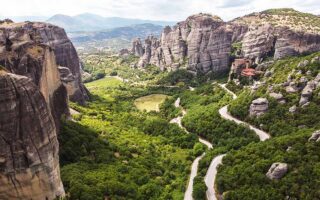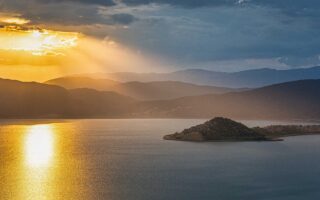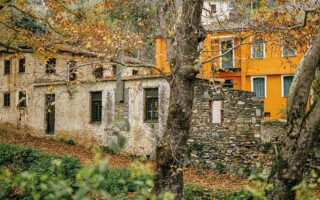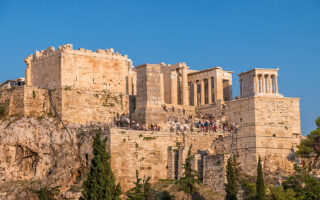Olive trees in their hundreds and thousands stretch as far as the eye can see in the area between Mount Pateras – an extension of Parnitha – and Corinthia’s Geraneia range in West Attica. Not many people know this, but the Greek capital’s oldest living olive grove is in Megara and, more specifically, in Kapsalos.
I toured the area with Ilias Pegkos, an agronomist who has been studying these trees for years. He stopped every so often to point out some of the most interesting ones, ancient trees bent by the years and the elements to resemble ornate sculptures.
Pegkos has made a record of around 100 ancient olive trees in the broader Megara municipality, and has taken an avid interest in studying their history and how they are connected to this area. Pointing to two trees growing a few dozen meters from each other, he asked me to identify which is the so-called “black olive tree,” an ancient variety that flourishes in Megara and has darker leaves than the main local variety, known simply as the “Megara olive.” Looking around to see if I could identify more black olive trees, I was impressed by the openness of the horizon. This openness is due to the fact that the trees are not planted close together, which, Pegkos explained, was the result of a law passed by the ancient Athenian lawmaker Solon, who decreed that a distance of 9 meters at least must separate the trunks of each tree.

More recent chapters of history are also evident in Megara, such as in the numbers painted onto the trunks of most of the trees we see. Pegkos explained that these numbers represent the owners. There appear to be too many owners to count, since each family would make sure that their prized asset was shared in such a way that every family member had a few trees to call their own. The area has been quite arid since ancient times, making the trees’ cultivation something of a challenge. But no challenge was too great for the ancients, and the 6th century engineer Eupalinos equipped Megara with a marvelous irrigation system. It is said that this was the first big public project executed by Eupalinos, who was a native of Megara, and that it continued to bring water to the town until the 1960s. The system comprised a network of channels built of stone at a depth of a few meters below the ground. Rainwater would filter through the soil and then be channeled to the town through the underground aqueduct.
As we left the olive grove, we came across a patch of land planted with healthy looking dill bushes. Pegkos explained that some plot owners plant other types of vegetables among the olives trees. In ancient times, in fact, Megara was renowned for its onion and garlic crops. Pegkos’ family also own a plot in the area where they grow various things and even though the agronomist is responsible for these crops, he still finds time for his passion project, which is protecting and raising awareness about the most important of Attica’s surviving ancient olive groves.
Byzantine churches
Another surprise for visitors to Megara is the seven Byzantine churches nestled among the olive trees. It is believed that at some point in their history – possibly after one of the many powerful earthquakes that have hit the area over the centuries – the residents of Megara moved their city to this part of the region. These beautiful Byzantine churches are the only things left from that town. Most notable among them are the churches of Christ and Agios Athanasios, not least because of the stone used to build them, which is riddled with the imprints of seashells – a reminder that many millennia ago Megara was below sea level.
Apart from olive trees, the people of Megara also grew grapes and passed down their vines to their children. This legacy is apparent on the road heading into the Geraneio Mountains on the border between Attica and Corinthia.
No challenge was too great for the ancients, and the 6th century engineer Eupalinos equipped Megara with a marvelous irrigation system
The grape varieties traditionally grown in this area are Savatiano, Roditis and Mouchtaro, according to vintner Christos Koulouriotis, whose winery, The Knack Project, adheres to biodynamic practices. His vineyard is at the end of a dirt road at an altitude of 630 meters in an area called Soras. The view from this vantage point is stunning, stretching all the way to the islands of Aegina and Diaporia. As we walked among his sprouting vines, Christos described a vine-growing technique known locally as “katourgia,” which involved burying a live branch and allowing the end to poke out of the soil so it will form new roots. He also said that the sharp fluctuations in temperatures in this area – which is among Attica’s highest vine-growing zones – results in good-quality wines.
As we headed down to the area of Mourtzia at 330 meters, I noticed the dramatic changes in the landscape: from rock and pine high up the mountain to hill lush with orchards and grapevines further down. We also drove past dozens of small stone farm buildings that have long been abandoned by the locals who once used them to store and press their grapes.
Folklore
Returning to Megara, I was welcomed to the town by the members of a local cultural association, who had prepared a feast of traditional dishes, such as “boubaria,” flute-shaped pies stuffed with spinach and raisins, and “trimeropita,” a cake-like sweet that is customarily offered by women to their mothers-in-law on the third day of Lent. The flavor is similar to tsoureki sweet bread and is often ornately decorated.
Like in other agricultural communities, spring is a very important time for Megara, full of traditional rites and customs, particularly around Greek Orthodox Easter, explained Evaggelia Pegou, who heads the cultural association.

One such custom involves a fete at the Church of Saint John the Dancer, where locals get together for the “trata,” a local dance where participants are joined with crossed hands to represent the cycle of life. The passion and detail with which Pegou talks about this and other customs made me wonder at how vivid the old way of life remains in this part of Attica, despite the short distance from Athens. It also gave me a desire to come back next Easter and further explore a part of Attica that clearly deserves more attention.
To reach the Byzantine churches in Megara’s olive zone, head out from the main square of Exo Vrysi, taking Agia Varvara Street to the north. Three blocks up, on the corner with Archiepiskopou Christodoulou Street, you can see a section of Eupalinos’ aqueduct with a signpost that explains what it is. Back on Agia Varvara, follow the signs for the churches of Christos, Agios Athanasios and Agios Georgios.
The Knack Project winery is open to visitors by appointment only (tel 6944.617434), while the area is also home to the Evharis Estate winery (tel 22960.903.46).
This article first appeared in Greek in Kathimerini’s Sunday supplement K.






